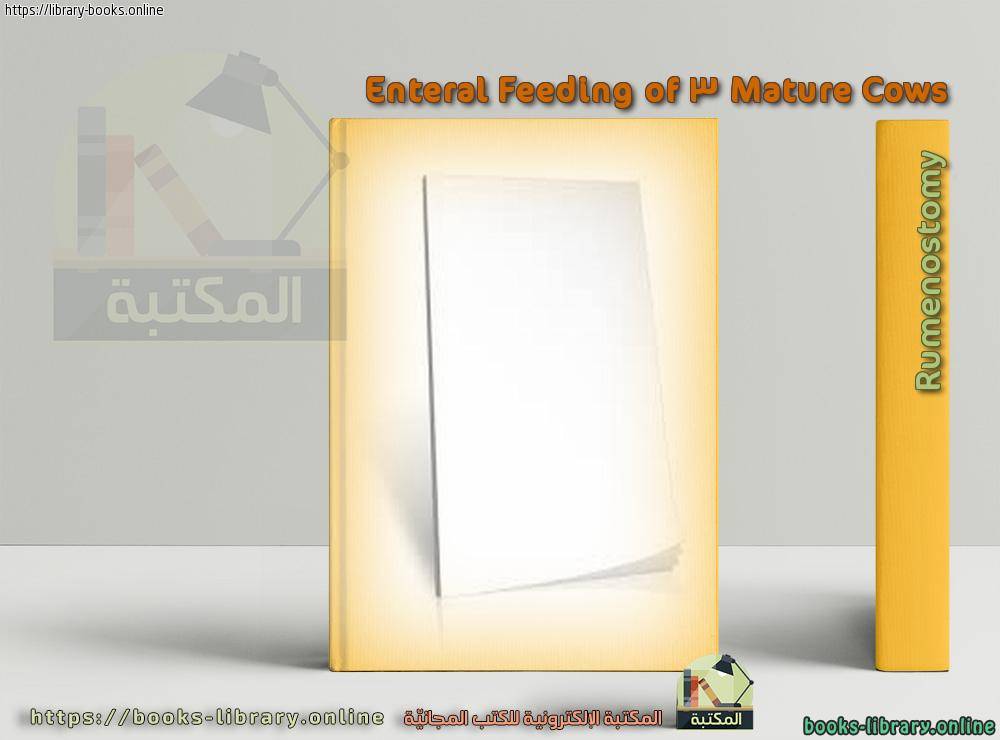📘 قراءة كتاب Enteral Feeding of 3 Mature Cows by Rumenostomy (p 779-781) أونلاين


تغذية معوية من 3 الأبقار الناضجة عن طريق الكرش فطريات (ص 779-781) من كتب طب بيطرى
تغذية معوية لثلاثة أبقار ناضجة من قِبل الكُرْمَةُ المَصْغِيّ Munashe
Chigerwe، Jeff W. Tyler، Maisie E. Dawes، Dusty W. Nagy، Loren G. Schultz،
Christopher D. Luby، John R. Middleton، and David Gourley
R
umenostomy is the creation of
والناسور دائم أو شبه دائم من الكرش.
ﻳﺘﻢ إﺟﺮاء اﻟﻌﺰﻟﺔ اﻟﺪاﺋﻤﺔ ﻟﻠﻜﺮم ﻟﺘﺴﻬﻴﻞ اﻟﺒﺤﺚ اﻟﺘﻐﺬوي أو ﺗﺰوﻳﺪ
اﻟﺠﻬﺎت اﻟﻤﺎﻧﺤﺔ اﻟﺴﺎﺋﻠﺔ.
1،2
Transfaunation هو
علاج فعال فعال في تربية الماشية من الجراحة.
2
نصوص قد
أوصت باستخدام فُطْر الكُرْمِ الرَّأْجِيّ لتَغْذِيَةَ مُعْتَمَلَةً
في الأبقار ذات النفخ المتكرر.
1
هذا التقرير
يصف استخدام فغر الكرش و التغذية المعوية
كعلاج مساعد في الأبقار غير القادرة على الأكل أو الشرب. وكرر
قد لا يتم التسامح مع التنبيب oroesophageal من قبل العديد من cat-
TLE وقطر الأنابيب المعدة يمنع عادة
توفير كميات كبيرة من الأعلاف.
تم
فحص البقرة البالغة من العمر 4 سنوات ، 510 كجم ، أنثى بقرة ألبان هولشتاين بسبب الترويل الغزير لمدة يومين.
انخفض إنتاج حليب البقر بشكل كبير. ذكر
المالك أن البقرة قامت
بمحاولات فاشلة متكررة للأكل والشرب. البقرة قبلت 1 أسبوع قبل
التقديم. تتكون حمية البقر من غير محددة
كميات من سيلاج الذرة ، قش العشب ، والأعلاف الأرضية. و
صاحب يعامل البقر مع البروكين البنسلين G
ل
(20000
وحدة دولية / كغ SQ q24h) قبل يوم العرض.
كانت البقرة مكتئبة. كانت درجة حرارة المستقيم 37.4
8
درجة مئوية ،
وكان معدل ضربات القلب 80 نبضة / دقيقة ، وكان معدل التنفس 52
نفسا / دقيقة. كانت البقرة تقدر بـ 8 ٪ من الجفاف
حسب تقييمها من قبل turgor الجلد. لوحظ وجود ميل في الرأس الأيمن.
ولوحظ وجود سيلان اللعاب ملحوظ ، وانحرف لسان البقرة
إلى الجانب الأيسر من تجويف الفم. كان البقرة
تسكين الوجه من الجانب الأيمن وكان غير مستجيب لمثيرات عن طريق اللمس
من الأذن اليمنى. Palpebral ، القرنية ، والتهديد إعادة
الرعاة كانوا غائبين في العين اليمنى.
لوحظ وجود قرحة القرنية في العين اليمنى. البقرة لديها عجز التحفيز
في كلتا العنصرين. ﮐﺎﻧت ﻣﺣﺗوﯾﺎت اﻟﮐرش
ﻣﺣﻔوظﺔ ﻋﻟﯽ اﻟﺗﻧﺎﻗض اﻟﻣﺳﺗﻘﯾﻣﻲ ، وﻟﮐن اﻧﻘﺳﺎﻣﺎت اﻟﮐرش ﮐﺎﻧت طﺑﯾﻌﯾﺔ ( ﺗﻘﻟﺻﺎن /
دﻗﯾﻘﺔ).
على تحليل البول ، كانت توجد أكسيديا (الأس الهيدروجيني ، 6.5 ؛ طبيعي ، 7–9) و
pro-teinuria (300 ملغ / ديسيلتر ؛ طبيعي
،
30 ملغ / ديسيلتر).
كثرة الكريات البيضاء (14،700 خلية /
م
L ؛ طبيعية ، 4000 - 12000 خلية /
م
L) تتميز بالعدلات (10440
خلية مجزأة /
م
L ؛ طبيعية ، 600-4000 خلية /
م
L) تم تحديدها على
CBC. أشار تحليل غاز الدم الوريدي إلى وجود أيض
من أقسام الطب والجراحة البيطرية (Chig-
erwe، Tyler، Dawes، Nagy، Schultz، Middleton، Luby) و Pathobiol-
ogy (Tyler، Dawes، Middleton) ، كلية الطب البيطري ، جامعة
ميسوري ، كولومبيا ، MO ، و Sertton البيطري Ser -
نائب ، جبل جروف (Gourley) ، MO.
طلبات إعادة الطبع: الدكتور موناش شيغيروي ، بكالوريوس علوم ، قسم
الطب والجراحة البيطرية ، كلية الطب البيطري ، جامعة
ميسوري ، كولومبيا ، MO 65211 ؛ البريد الإلكتروني: chiger-
wem@missouri.edu.
مقدم في 22 مارس 2005. تمت المراجعة في 21 أبريل 2005 ؛ مقبول مايو
5، 2005.
جميع الحقوق محفوظة
ف
عام 2005 من قبل الكلية الأمريكية للطب البيطري الداخلية
الدواء
0891-6640 / 05 / 1905-0023 / 3.00 / 0
idosis (الأس الهيدروجيني ، 7.19 ؛ المعدل الطبيعي ، 7.35-7.5) ، تركيز بيكربونات
(9.7 مللي مول / لتر ، طبيعي ، 17–29 ملمول / لتر) ، TCO
2
( 10.5
ملمول / لتر ؛ طبيعي ، 19–29 ملمول / لتر) ، وعجز أساسي قدره 18.7
ملي مول / لتر. شملت نتائج تقييم البيوكيميائية المصلية
زيادة تركيزات نيتروجين اليوريا (44 ملغ / دل ؛ noram
، 6-22 ملغ / ديسيلتر) ، الكرياتينين (1.4 ملغ / ديسيلتر ؛ طبيعية ، 0.5-1.1
ملغ / ديسيلتر) ، الجلوكوز (218 ملغ / L ؛ طبيعي ، 44-78 مجم / ديسيلتر) ، بروتين
(9.2 غ / دل ؛ طبيعي ، 5.8-7.5 جم / غل) ، ألبومين (3.8 غ / دل ؛
طبيعي ، 2.4-3.5 غ / دل) ، و الجلوبيولين (5.4 غ / دل ؛ طبيعي ، 2.3 -
3.9 غم / لتر). نشاط المصل AST (202 U / L ؛ طبيعي ، 58-100
تم زيادة U / L) ، GGT (75 وحدة / لتر ؛ طبيعي ، 22-64 U / L) ، وكيتس الكرياتين
(1،365 U / L ؛ طبيعي ، 56-1.236 U / L).
حدد تحليل السائل النخاعي (CSF) زيادة
تركيز البروتين الكلي (113 مغ / دل ؛ طبيعي ، 20-40 ملغ / ديسيلتر) ؛
زيادة الخلايا الليمفاوية والخلايا أحادية المنشأ ،
والبلاعم الضامة النشطة (83 خلية /
م
لتر ، طبيعي
،
6 خلايا /
م
لتر). A quan-
لم يتم توفير عدد خلايا titative التفاضلية. واستناداً
إلى العلامات الإكلينيكية ونتائج تحليل CSF ، تم إجراء
تشخيص افتراضي للداء الليستريات. لم يتم استرجاع
الليستيريا مونوسيتوجين
من ثقافة CSF ، ولكن
الثقافات البيولوجية شائعة في الأبقار مع الليستريات.
3-5
تم إجراء فغر الورم.
تم حساب العجز الأساسي للبقرة على النحو التالي: العجز الأساسي (ملمول / لتر)
5
0.5
3
510 كجم
3
18.7 ملمول / لتر
5
4769 ملي مول.
6 تم حساب
عجز السوائل
بـ 510 كجم
3
0.08
5
40.8 L. وقد
تم تقدير متطلبات سوائل الصيانة على أنها 40.8
L / d إضافية (80 مل / كجم / د).
7
بالنظر إلى أن 1 غرام NaHCO
3
يوفر ما
يقرب من 12 ملي مول من بيكربونات ، فإن البقرة تتطلب ما يقارب
400 غرام من بيكربونات الصوديوم لتحل محل
العجز الأساسي. في البداية ، كانت
تدار 30 لتر من الماء ، 3 مرات في اليوم ، عن طريق الكرش. في كل إدارة
للمياه ،
تم إذابة 50 غرام من كلوريد البوتاسيوم ، و 40 غرام من كلوريد الكالسيوم ، و 130 غرام من بيكربونات الصوديوم في
الماء. كانت البقرة تغذي 1.5 كيلوجرام من
مزيج حبة الأبقار التجارية المتوازنة
ب
و 2.5 كيلوغرام من البرسيم الحبيبي
ج
3 مرات
في اليوم من خلال فطريات الكرش ، مما يوفر
17.5 تقريباً من طاقة ماكال الصافية (NE) في اليوم.
8 تم إضافة
الحبوب والبرسيم الحبيبي
الجاف من خلال قمع
وتمت إدارة المحاليل المنحل بالكهرباء من خلال الومضة باستخدام الكبر
تتحمل أنبوب المعدة في كل تغذية. تم إعطاء الـ Oxytetracycline
d
عند 10
مجم / كجم مرة واحدة يومياً. تم إعطاء
مرهم مضاد حيوي لمضاد مبيض العين
e
، OD12H. وأظهرت
قرارات كيمياء المصل المتكرر بعد 24 ساعة من
القبول أن البقرة كانت تعاني من
الحماض الأيضي المعتدل (الرقم الهيدروجيني ، 7.31 ؛ العجز الأساسي ، 4.6 مليمول / لتر ؛
تركيز البيكربونات ، 21.8 مليمول / لتر ؛ TCO
2
، 23.2 مليمول / لتر).
استمرت السوائل داخل الكالسيوم والإلكتروليت.
واستناداً إلى العجز المُقاس ، كانت كمية ثاني كبريتات الصوديوم
المدارة من خلال فُرغ المعدة
مبررة حتى 30 جم q8h. استمر كلوريد الكالسيوم داخل الكلى وكلوريد
البوتاسيوم. بعد ثلاثة أيام
من التمكن ، كانت البقرة قادرة على تناول الطعام والشراب ببطء ، ولكن
بصعوبة كبيرة. كانت تحديدات كيمياء مصل الدم في اليوم الثالث
بعد التقديم متوافقة مع الحمض العادي
Cows
cow wikipedia
information about cow
cow cartoon
cow farm
cow
سنة النشر : 2005م / 1426هـ .
حجم الكتاب عند التحميل : 27.2 كيلوبايت .
نوع الكتاب : pdf.
عداد القراءة:
اذا اعجبك الكتاب فضلاً اضغط على أعجبني و يمكنك تحميله من هنا:

شكرًا لمساهمتكم
شكراً لمساهمتكم معنا في الإرتقاء بمستوى المكتبة ، يمكنكم االتبليغ عن اخطاء او سوء اختيار للكتب وتصنيفها ومحتواها ، أو كتاب يُمنع نشره ، او محمي بحقوق طبع ونشر ، فضلاً قم بالتبليغ عن الكتاب المُخالف:
 قبل تحميل الكتاب ..
قبل تحميل الكتاب ..
يجب ان يتوفر لديكم برنامج تشغيل وقراءة ملفات pdf
يمكن تحميلة من هنا 'http://get.adobe.com/reader/'


 منصّة المكتبة
منصّة المكتبة